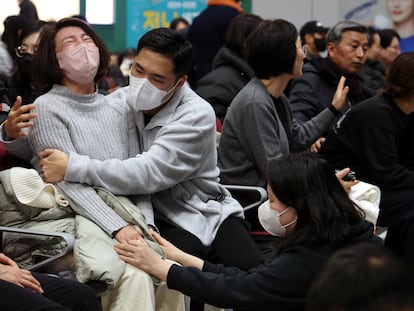Maps and charts to explain what is known about the accident in Washington
The helicopter’s GPS signal shows that it had taken off shortly before the crash. Aircraft collisions accounted for 12% of all aviation accidents last year
A commercial airliner and a military helicopter collided Wednesday night near Ronald Reagan Washington National Airport, the closest airport to Washington, D.C. The passenger plane, which was flying from Wichita, Kansas, was carrying 64 people. The helicopter, which was on a training mission, had three people on board.
The collision occurred at 8:48 p.m.local time (ET). The commercial flight was already in its descent phase toward the landing strip, where it was scheduled to land at around 9:00 p.m. ET. According to its last positional data, it was at an altitude of 300 feet (91 metres) at the time of the crash. The helicopter’s positional data is more limited as it was not a commercial aircraft and the last before the collision placed it at around 400 feet (122 meters).
Although the number of fatalities is still unknown, local authorities have said that they expect to recover no survivors given the explosion that followed the crash and the weather conditions in the area: sub-zero temperatures around the Potomac River and strong winds have complicated search and rescue efforts.
Collisions, 13% of accidents
Aircraft crashes are not common. In 2024, there were 25 collisions between aircraft in flight worldwide, taking into account all types (private, commercial, military, tourist, etc.). That represents about 13% of the 193 accidents recorded in the Aviation Safety Network database, a count that also includes minor crashes on the runway that did not result in any victims. These are a tiny fraction of the more than 37 million flights recorded annually.
Yet, for two years now, there has been public debate in the United States about how greater air traffic and staff shortages have increased the risk of aircraft collisions. An investigation by The New York Times found that in 2022, there were 300 warnings of collision risks involving commercial airlines. These were almost always near airports and due to human error. The number of these near-misses has multiplied in the past decade, although it is not clear whether safety conditions have worsened or whether there has been an increase in the reporting of such dangers.
One death for every 20 million passengers
According to data from the International Air Transport Association (IATA), in 2023 there was one air accident for every 1.26 million flights.
Over the past 55 years, the fatality rate on commercial flights has been in almost constant decline, with exceptions such as 1985, when almost 2,500 passengers died (1,500 of them on six flights). In 2021, the most recent year with available data, there were 0.05 deaths per million passengers (i.e. one death for every 20 million passengers).
Taking into account the passenger figures, Wednesday’s accident is not among the 100 worst recorded in aviation history: all of them resulted in over 100 victims. Among those was the 1984 disaster at Los Rodeos airport in Tenerife, Spain, where the collision of two airplanes caused 584 fatalities.
Sign up for our weekly newsletter to get more English-language news coverage from EL PAÍS USA Edition

